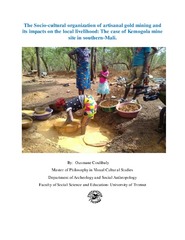The socio-cultural organization of artisanal gold mining and its impacts on the local livelihood. The case of Kemogola mine site in southern-Mali
Permanent lenke
https://hdl.handle.net/10037/11210Dato
2017-05-12Type
Master thesisMastergradsoppgave
Forfatter
Coulibaly, OusmaneSammendrag
The thesis explores the socio-cultural organization of the artisanal gold mine of Kemogola located in southern-Mali. I carried out this fieldwork during three months in the gold mine of Kemogola. Through the participant observation method with the extend use of the video camera recording and the block notes I gathered the empirical data which reflect social realities of my informants.
Indeed, I observed four main layers (actors) who are engaged in the gold mine management and its social organization. The hunters represent the police; they are in charge of the mine security. Those hunters work closely with the gold mine association members so-called Ton-Boloma. Together they implement their own rules of conducts and norms related to the safety and general well-being of the mine community.
Moreover, the traditional authorities (landowners) and the modern authority represented by the municipality are also involved in the system and are working with the hunters and Ton-Boloma. After pegging and distributing mine plots to miners, they take money from each mine pit. Regarding to mining activity processes, before starting, the miners form some working teams and each person has a specific role. I observed that the activity has three main steps: digging, pulling the rope and washing the mud for gold.
The artisanal mining is an important activity in this local community. Today, there is a great influx of both urban and local peasant to the gold mine. During my investigation, I found that diverse and complex reasons explain their attractions to the mine.
Further, the miners come from different areas from Mali and neighboring countries, with different identities, languages and cultural background and their contact with the natives of Kemogola have had an impact on the local lifestyle, producing a dynamic cultural mix and exchanges.
Forlag
UiT Norges arktiske universitetUiT The Arctic University of Norway
Metadata
Vis full innførselSamlinger
Copyright 2017 The Author(s)
Følgende lisensfil er knyttet til denne innførselen:


 English
English norsk
norsk
